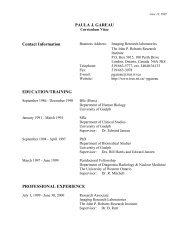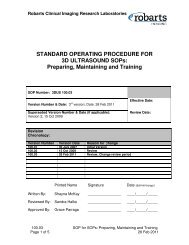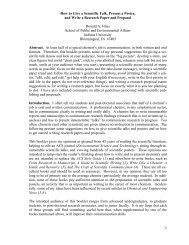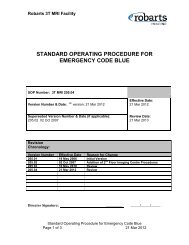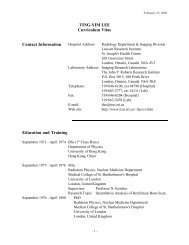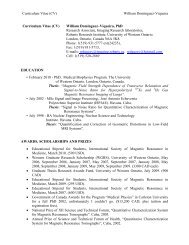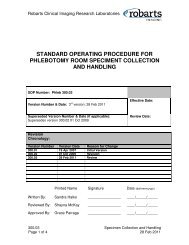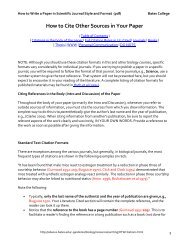how to read a scientific [journal] article - Robarts Imaging
how to read a scientific [journal] article - Robarts Imaging
how to read a scientific [journal] article - Robarts Imaging
- No tags were found...
Create successful ePaper yourself
Turn your PDF publications into a flip-book with our unique Google optimized e-Paper software.
HOW TO READ A SCIENTIFIC ARTICLE"Probably what you should learn if you are a graduate student isnot a large number of facts, especially if they are in books, butwhat the important problems are, and <strong>to</strong> sense which experiments,work that has been done, probably aren't quite right."James Watson, of Watson & Crick (DNA fame)When students in the sciences are first faced with using the primary research literature,the prospect sometimes seems overwhelming. Finding pertinent <strong>journal</strong> <strong>article</strong>s often seems <strong>to</strong>involve a maze of abstracting <strong>journal</strong>s, indifferent librarians, missing volumes, CDroms fromhell, and bound periodicals that refuse <strong>to</strong> flatten themselves for pho<strong>to</strong>copiers (no matter <strong>how</strong>hard you press on them, CPR-style). Even once an <strong>article</strong> has been located--or, in the case ofthis class, provided--there is the problem of <strong>read</strong>ing it. The worst way <strong>to</strong> assimilate a researchpaper is <strong>to</strong> <strong>read</strong> it word for word, title <strong>to</strong> literature cited, as if it were a textbook. This approachis a waste of time, because perhaps as few as 1 in 4 <strong>article</strong>s that find there way in<strong>to</strong> your handsshould be committed <strong>to</strong> your brain, and is deadly boring.Before <strong>read</strong>ing one word of an <strong>article</strong>, ask yourself: What am I looking for in this <strong>article</strong>?Knowing what I do about the subject, what gaps need <strong>to</strong> be filled, what knowledge needs <strong>to</strong> beexpanded, and what controversial points need <strong>to</strong> be corroborated? Generate expectations of a<strong>journal</strong> <strong>article</strong> before you <strong>read</strong> it. This will help your analysis of the work in front of you, pluskeep you more interested in the material. Then what:1. Read the authors' names. Where and with whom are they working? What is their expertise?Names may mean little at first, but as you "wade through" a <strong>scientific</strong> subject or <strong>to</strong>pic you willfind familiar names cropping up, and you will develop those with whom you agree and thosewhom you question.2. Read and digest the title. It should summarize the work of the <strong>article</strong> well, help you <strong>to</strong> clarifyyour expectations of the paper, and it should be an attention-getter (if you are <strong>read</strong>ing the<strong>article</strong>, it has probably al<strong>read</strong>y accomplished that task!).3. Read the abstract carefully and try <strong>to</strong> understand it (though it may be the densest prose youwill ever encounter). Abstracts are as difficult <strong>to</strong> <strong>read</strong> as they are <strong>to</strong> write, because an entirepublication must be summarized in an understandable way in only about 200 words. By now,you should have a good idea of what the paper is about and what you have gotten yourselfin<strong>to</strong>. At this point, it may be obvious that the paper does not answer your questions. If this istrue, move on, but be conservative because the authors' interpretation of the research presentedin the abstract may not be the same as yours after <strong>read</strong>ing the full paper. Never cite an <strong>article</strong>after having <strong>read</strong> only the abstract!4. Picture time--flip through the <strong>article</strong> and study the figures, illustrations, and tables, includingthe legends. It will probably become necessary <strong>to</strong> consult the Methods and Results section <strong>to</strong>clarify figures and understand the experimental design. If the <strong>article</strong> is closely related <strong>to</strong> yourresearch, closely examine the techniques described in the Methods section. There may beproblems there, but more likely there will be a new, perhaps better, approach <strong>to</strong> your ownresearch. It should be clear <strong>to</strong> you by now whether this paper will be truly helpful. If so, nowit is time <strong>to</strong> be critical (please, see the note below about this word).5. Read the Introduction and be sure the author knows the field, has adequately researched pastwork, and understands where their work "fits in<strong>to</strong> the puzzle". Generally, the Intro and
Literature Cited sections go hand-in-hand. Most importantly, within the first paragraph or 2of the Introduction the authors should have made it very clear what their objectives for theresearch were, and what their paper will tell you.6. Check <strong>to</strong> see if the Results adequately and accurately describe the data presented in the paper.Are there additional points that should have been brought up? Is there something in thefigures or tables that does not substantiate the authors' claims that was not mentioned? Do thefigures and tables clearly, succinctly, and attractively present the results of the paper?Remember that great data presented clumsily or sloppily will not be seen as great, onlyclumsy or sloppy.7. Now <strong>read</strong> the Discussion. This is perhaps the most important section, because it is here thatthe results (the "what" of the research) are explained. That is, here is where the authors should[at least try <strong>to</strong>] explain "why" they saw what they saw. Beware of unsubstantiatedspeculation, though do not fault, off-hand, the presentation of hypotheses for future work oreven expectations of findings from those future experiments. On the other hand, there areauthors who are prone <strong>to</strong> timidity, understatement, or who are just plain invertebrate abouttheir ideas. You should not be left guessing, or left <strong>to</strong> fumble <strong>to</strong> your own conclusionsbecause an author was unwilling <strong>to</strong> take even a small step out on<strong>to</strong> a limb. As a moderateexample of such understated conclusions, Watson and Crick ended their his<strong>to</strong>ric presentationof the structure of DNA with the sentence: "It has not escaped our notice that the specificpairing we have postulated immediately suggests a possible copying mechanism for thegenetic material." In fact, the complimentary base pairing they presented was no less that aquantum leap in our understanding of biological systems, in terms of both modernbiochemistry and evolution!Bear in mind that the ultimate burden of assessing published material lies with you, the<strong>read</strong>er. Take the time and energy <strong>to</strong> do this and you will gain more and be further along that theperson who depends on the author for interpretation. Having just completed a critical <strong>read</strong>ingand assimilation of a <strong>journal</strong> <strong>article</strong> pertinent <strong>to</strong> your work, you should be able <strong>to</strong> paraphrase thesignificance of this paper with 3 or 4 sentences free of technical jargon. You should also be able<strong>to</strong> both praise and criticize several points of the paper (this is important--see note below). Ageneral rule of thumb, regarding what goes where, when both <strong>read</strong>ing and writing a <strong>scientific</strong><strong>article</strong> is:Title: Short, succinct, eye-catching, all-encompassingAbstract: Summary of Methods, Results, and Discussion starting off with a statement of why theresearch was done and with emphasis on why the results are significant.Introduction: When was past work done, by whom, why was their work important, what youplan <strong>to</strong> do in your paper, and why what you did is important.Materials and Methods: How you did what you did and where you did it--nothing more.Results: What the data s<strong>how</strong> you--nothing more.Discussion: Why the data s<strong>how</strong> what they s<strong>how</strong>, and <strong>how</strong> your analysis relates back <strong>to</strong> yourobjectives from the Introduction.Note: Some <strong>journal</strong>s will allow the Results and Discussion sections <strong>to</strong> be combined. In thiscase, the data should be divided up in<strong>to</strong> logical groups, and for each group (generallyseparated by a subheading) the What and the why are presented <strong>to</strong>gether.


![how to read a scientific [journal] article - Robarts Imaging](https://img.yumpu.com/44345644/1/500x640/how-to-read-a-scientific-journal-article-robarts-imaging.jpg)

